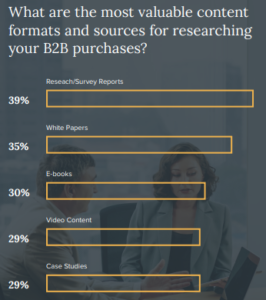
Whitepapers sometimes get a bad rap in the content marketing world as being super-technical documents best suited for equally technical companies and industries. But this perception is outdated. Today, all kinds of companies are producing whitepapers that help customers solve problems, drive leads and conversions, and demonstrate expertise.
Demand Gen’s most recent Content Preferences Study found that whitepapers rank in the top two (behind only video — the new king of content) for the most valuable type of content for researching B2B purchases. It’s also one of the most-shared types of content among colleagues in B2B industries.
Whitepapers, when done effectively, can help your customers accomplish important goals while driving your lead generation and conversion efforts at the same time.
Here’s how to create whitepapers that deliver the most customer value and drive results for your band.
Quick Takeaways
- Whitepaper topics should always be centered around helping customers solve a problem or accomplish a goal.
- Professionalism is key for whitepapers: a business writing style, thorough fact-checking, and quality proofreading are essential.
- Whitepapers should always include high-impact, engaging visuals and design.
- Brands should always gate whitepaper content to capture customer information and generate leads.
How to Create a Great Whitepaper: 8 Best Practices
Build Your Topic Around Customer Needs
So you’re ready to develop a whitepaper. What should you write about?
Don’t just pull a topic out of the air or choose one randomly because it’s familiar. The best whitepapers help customers solve a real problem or accomplish an actual goal. This means that when you’re choosing a whitepaper topic, you should always do it from your customer’s perspective.
Let’s take a minute here to talk about what whitepapers are not. They aren’t brochures or promotional documents. They aren’t product overviews or company reports. In fact, one of the biggest mistakes companies make when they create whitepapers is they make it about them.
This is usually done with good intention, but it doesn’t make it any less off the mark.
Your potential customer will typically encounter your whitepaper while in the process of searching for a brand who can provide a solution. What better way to convince them that your brand is the best choice than by providing a solution right away with your content?
This doesn’t mean you’ll solve all of their larger problems or eliminate their need for your services. It means that you’ll demonstrate the value you can provide and entice them to want more from your brand.
To think like your customer, you’ll need to use strategies centered around empathy.
As marketers, we spend so much time immersed in our products and services that we can lose sight of why they exist in the first place. By using empathy to think from the perspective of our customers, we get back to the core purpose of our brand.
One helpful tool you can use to practice using empathy is the jobs-to-be-done (JTBD) methodology, which works by focusing not on your products or even who your customer is. Rather, it looks to uncover what your customer is trying to accomplish.
Here’s more on JTBD theory:
Once you’ve explored your customer needs, you can confidently explore topics that will deliver valuable solutions.
Use a Professional Tone
Whitepapers should never be dry and boring, but they also aren’t the place to use informal language. The tone of a whitepaper should always be professional.
Use a business writing style, remain fact-based, and include clear descriptive language. Your whitepaper is a guide for customers to help them accomplish something real that will make an impact on their job and organization. It’s definitely not the place for opinions.
Backup your content with research and statistics. Whenever possible, conduct and leverage your own firsthand research to support important points. Remain objective and use language that does the same.
Pack it with High-Value Content
Whitepapers are created to add additional value not already offered on your blog or in your other free content. As you choose your topic and begin to develop your whitepaper, you should continually ask yourself: how is this content providing unique value to my customers?
Here are some ways you can pack your whitepaper with value your customers will appreciate:
- Provide clear action steps customers can take to implement solutions
- Include research and statistics that help customers make informed decisions
- Use real-world examples to demonstrate your important points
- Keep it interesting using graphics, stories, and quotes to break up your content
Use Engaging Visuals to Support Your Text
A common misconception is that whitepapers are text-only, academic type documents that don’t or shouldn’t contain images or design. We’ll touch more on design later, but we’ll start here by saying your whitepaper absolutely should include visual images to support your text content.
In general, people only read about 20% of what they see on any given page. They notice and retain visual information at a much higher rate. You should emphasize your most important points using compelling images and graphics that catch your reader’s attention as they read.
That said, images in whitepapers should fit in with its overall professional tone and purpose. While blog images can vary and be more casual, whitepaper images should remain formal. Good ideas for whitepaper images include graphs, charts, tables, and highlighted statistics that create visual representations of the information you’ve included in your text.
Here are some good examples:
This is an image included in the Demand Gen study we cited earlier in this article:

Image Source
It’s simple and uncomplicated, but it visually demonstrates the statistic Demand Gen was discussing rather than simply including it in text paragraphs.
Highspot’s whitepaper on How to Overcome Top Marketing Challenges reports a high volume of survey results and uses color-coded bar graphs to make the statistics clear:

Image Source
High-quality stock photography is another great way to incorporate imagery into your whitepaper. It may not be reporting on actual content, but it can help paint a picture of the topics you’re covering and make your whitepaper more engaging.
For example, if you were writing a whitepaper on creative marketing strategies, you could include stock photos showing creative teams working together.

Image Source
This image may not actually communicate information, but it sets the tone you intend for the content and evokes emotion (all images do), an important component of getting customers to take action.
Fact Check Everything
We’ll keep this one short and sweet: fact check every single thing you include in your whitepaper. Be sure your statistics are all reliably sourced, and always include your sources in the actual whitepaper.
Whitepapers are intended to position your brand as an expert. Nothing could undermine that more than inaccurate or poorly sourced information. Take the extra time to find information from sources you can trust and be sure your own research is accurate before you include it.
Proofread (More than Once)
Like fact-checking, proofreading your content is essential. Even the smallest mistakes such as misspelled words or incorrect grammar can paint a poor image of your company.
Attention to detail is key here. Find someone on your team who has the experience and capability to confidently proofread and copy edit your content. Ideally, more than one person should proofread to ensure you don’t miss even a single error!
Don’t Forget Design
A sleek, professional design can go a long way. Not only does great design make your whitepaper appear more professional, it also makes it more approachable and engaging. Don’t be fooled by that outdated perception of whitepapers being technical documents. You’re creating it to engage your audience and just like any other marketing collateral, it needs design to help accomplish that goal.
Design is an area that’s best to outsource when you don’t have the in-house team to do it well. Poor design can sometimes be worse than no design at all (and no design is pretty bad).
If you’ve taken the time to develop high-value whitepaper content, go the extra step and invest in a great design that brings it to life.
Gate Your Whitepaper to Drive Conversions
Last but certainly not least: be sure you leverage your whitepaper to produce results! You’ve spent a lot of time creating a whitepaper that offers exceptional value, is well-researched and well-designed, and helps your audience solve a real business problem.
It’s perfectly reasonable, then, to ask for your potential customer’s email address in return for the whitepaper download. In fact, it’s a total miss if you don’t.
Whitepapers are one of the most effective types of lead magnets for capturing leads. Be sure that you put an effective strategy in place to help it perform.
Create a Compelling Whitepaper without the Stress
Content agencies have the experience and resources to craft content that drives results. If you’re ready to create a compelling whitepaper and deliver other exceptional content to your audience, Marketing Insider Group has solutions that can help.
Check out our Content Builder Services or schedule a free consultation to learn more!
The post How to Create Great Whitepapers appeared first on Marketing Insider Group.
----------------------------------------------------------------
By: Michael Brenner
Title: How to Create Great Whitepapers
Sourced From: marketinginsidergroup.com/content-marketing/makes-great-whitepaper/
Published Date: Tue, 19 Oct 2021 09:00:00 +0000
Did you miss our previous article...
https://coachingbusinessowners.com/growth/new-yelp-features-aimed-at-small-service-businesses






